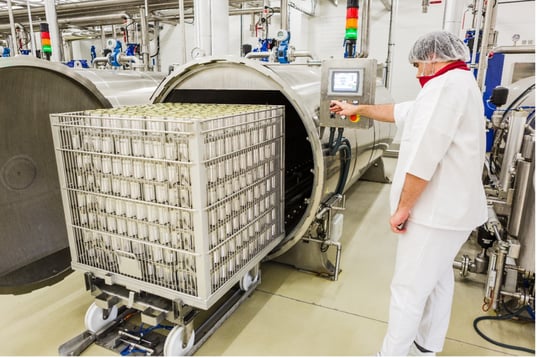Retorts for sterilizing food and beverages are typically robust equipment that requires low maintenance. Even so, it is essential to carry out some regular tasks to keep the retort clean. By following simple steps, some major benefits will be obtained: the useful life of all the equipment will be extended, costly repairs will be avoided, and the quality of our processes will be increased. For this reason, some keys should be taken into account to keep the retort clean.

Prioritize preventive maintenance over reactive maintenance
Retort cleaning tasks must be approached as part of the retort’s preventive maintenance. The equipment parts that need to be cleaned regularly are:
● Spray nozzles
● Recirculation suction grids
● Recirculation strainer
● Heat exchanger
● Levels system
● Door seal
These cleaning tasks are essential to avoid the accumulation of dirt in the recirculation and achieve a constant water shower flow. They also remove impurities that may get stuck in the levels system and obstruct its proper functioning.
Schedule cleaning tasks and monitor their fulfillment
Integrating cleaning actions as part of regular maintenance is a must. In this way, it is possible to extend the life of the equipment and ensure the safety and quality of the sterilization. Each retort will have its specific cleaning requirements, depending on the intensity of use, the equipment model, and the sterilization technologies used.
Even so, these tasks can act as a guide for proper regular cleaning:
● Daily actions:
Cleaning and lubrication of the gasket.
Cleaning of the pump suction grids.
● Once a week:
Cleaning of the recirculation filter.
● Once a month:
Cleaning of the water level controller.
● Six-monthly:
Cleaning of the spray nozzles.
● Annually:
Spreaders.
Follow the instructions in the manual to comply with the installation specifications.
Some retorts require regular draining and interior cleaning to guarantee the safety of the process, while such tasks are not required for other equipment. Cleaning and maintenance actions will always depend on diverse factors, including the work intensity, the type of sterilization processes, the containers used, and the installation quality.
Therefore, cleaning actions should be established in accordance with the manuals for each piece of equipment. This documentation will indicate specific tasks to be carried out, as well as the type of consumables that should be used to extend the proper functioning of the installation. In this respect, it is essential to always ask manufacturers for complete manuals that include all of the necessary information in terms of cleaning and maintenance.
Always use low-acid products.
To avoid damaging the equipment, using low-acid cleaning products with a pH below 6 is a must. Surfaces should be cleaned using non-abrasive sponges or cloths and distilled or demineralized water.
Cleaning tasks must always be carried out when the machine is switched off and cold to avoid accidents and damage to the equipment.
Opt for quality sterilization equipment that requires low maintenance
Surdry retorts are designed and manufactured under high-quality standards with the ultimate goal of offering long-term resistance against potential faults or breakdowns due to wear.
Provided that simple cleaning tasks are performed regularly, the life of the equipment will be extended, hence increasing the profitability of the investment. Furthermore, as part of the preventive maintenance, cleaning is an essential aspect to avoid unscheduled downtimes, repairs and faults that may jeopardize the quality of the products.


